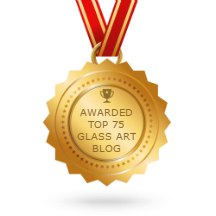Cutting small circles in glass is difficult, at least for me. I have gotten pretty good at circles over 3″ and am better when the glass is transparent rather than opal. But typically less than 3″ and the tools are hard to use or I don’t have a the right tool or … it is just me. 🙂
To make very small dots, I use course frit, laying the pieces directly on a kiln shelf, fusing to 1500 degrees and each piece kind of sucks in and becomes a small dot.
In my recent flameworking class at Bullseye, I learned to also make small dots by heating the glass rod while holding it perpendicular to the steel plate below and letting the glass drop in small circles onto the steel plate. These dots tend to be cleaner, meaning they don’t have any kiln shelf residue on them which may show later when using them especially if they are transparent.
How to make dots in between these sizes? In another class at Bullseye, we used some scrap glass to make magnets by heating about 9mm high stacks of glass (mostly cut into squares) to 1525 degrees F and as it heated to this high temperature and the glass naturally tries to get to 6mm, the sides spread out and the squares became circles. Perfect, or so I thought.
I am part of a wonderful community whom I met through Etsy called O.C.E.A.N. which stands for Oregon Coast Etsy Artist Network. Those who are physically close to Coos Bay, Oregon, get together once a week to build camaraderie, share ideas, develop joint plans for events and brainstorm how to help the greater team and then they share their conversations on Etsy and Facebook. Anyway, several of the members are going to share a booth at an event in September in Coos Bay called ZombieFest and I decided while I can’t be there physically, I wanted to participate. Since I have to send the items to Oregon and then what doesn’t sell have sent back, I decided to work on smaller pieces and decided Zombie eye magnets were just the ticket.
So I started some tests. I created 1″ vanilla circles for the eyeball base, and then also created smaller yellow circles and even smaller black circles all using the square technique I described above and layering each color with clear.

My Small Yellow and Black Circles
I then stacked the completed circles together (vanilla on bottom, then yellow, then black) adding small red stringers for bloodshot-ness and fused again. However this time, I fused to only 1450 degrees F (normal fusing temperature for my kilns) since the individual pieces were already circles.

Stacked Circles Ready for the Kiln Again
What was interesting out of this test is that while the individual pieces were circles before the final fuse, when they fused together, some of them appeared to try to go back to their initial square shape. It could be that I should use a lower fusing temperature. Or it could be making my circles with both clear and the color as perhaps what appeared to be a black circle wasn’t really completely black all the way around. It may be better to stack all black squares as an example rather than black and clear.
The good news is that Zombie eyes are not exact and so while these would not pass for real eyeballs, for Zombie eyeballs, why not!

Zombie Eye Magnets
If anyone knows how to make perfect small circles, please reply and share with others! Inquiring minds would love to know!!!
NOTE: I learn much of what I know from reading other websites, classes and blogs and hence, I haven’t really invented anything new here. But I am sharing what I found to work and not work. If you have found other ways to do something similar to this, please share!
Read Full Post »
















